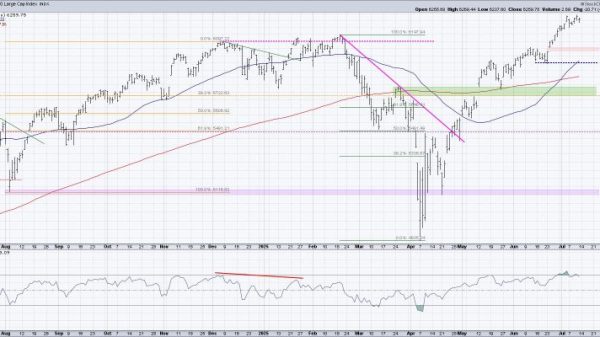The evolution of technology has undoubtedly grabbed the interest of the general public and investors alike as innovation in diverse categories continues to move forward at a remarkable speed.
Overall, the technology sector has come a long way in the last two decades. In March 2000, the S&P 500’s (INDEXSP:.INX) technology index hit its peak of 988.49 points, rising by almost 500 points in the five years leading up to the dotcom bubble. Similarly, the NASDAQ reached an all-time high of 5,000 points during this milestone period.
As of March 2024, the S&P 500’s technology index had grown by more than 500 percent, while the NASDAQ had more than tripled. The tech market is now dominated by large players, with companies like Meta Platforms (NASDAQ:META), Apple (NASDAQ:AAPL), Amazon (NASDAQ:AMZN), Netflix (NASDAQ:NFLX) and Alphabet (NASDAQ:GOOGL) creating vast monopolies.
With so much growth in the technology sector over the last two decades, tech developments are disrupting and shaping our cultural fabric at unprecedented speeds. Industries such as finance, real estate, transportation and healthcare are transforming with current technological advancements. Here’s a breakdown of why investors should pay attention.
What should investors know about the tech market?
The past decade or so has seen the evolution of countless tech-related industries.
Take, for example, the cable industry, which has been transformed by video streaming. As of Q4 2023, Netflix (NASDAQ:NFLX) had expanded to over 190 countries worldwide with a subscriber base of 260 million. The streaming service giant generated US$33.7 billion revenue in 2023, a 6.6 percent increase on the previous year. Amazon Prime Video has also exploded in recent years, with over 230 million subscribers and revenues of US$40.2 billion in 2023.
Apple’s Apple TV Plus and Disney’s (NYSE:DIS) Disney Plus have joined the ranks of video-streaming service companies as well. While Apple has withheld the number of users it has garnered since launching in 2019, estimates put at upwards of 25 million for 2023. Disney Plus, which debuted the same year, had amassed more than 150 million subscribers as of February 2024.
Gaming is another industry benefiting from advancements in streaming technology. The mobile gaming market is growing faster than any other gaming segment in the world, according to market intelligence firm Precedence Research, which estimates that the segment brought in US$184.4 billion in 2022, equivalent to about half of global gaming revenue. In the years ahead, growth in global smartphone sales, cloud gaming, 5G and mobile infrastructure are expected to sustain growth in the mobile gaming sector.
The ‘fourth industrial revolution’ has been tied to various disruptive technologies, including artificial intelligence (AI), 3D printing, and blockchain. The global AI market was worth US$196.63 billion in 2023, according to a Grand View Research report, with research and innovation spurring activity in verticals like the automotive, healthcare and finance industries. These segments are adopting solutions like machine learning, robotics, neurolinguistic programming and querying methods.
3D printing, valued at US$20.37 billion in 2023, may be a niche market, but it’s growing rapidly based on a number of factors including the technology’s variety of benefits, such as mass customization, the production of complex parts and the ability to improve efficiencies in the manufacturing process.
Blockchain has, of course, also garnered interest in the tech sector; the size of the global market hit US$17.46 billion in 2023. Within this tech space, Grand View Research highlights “DeFi as an emerging financial technology based on blockchain, which reduces the control banks have on financial services and money.”
Which tech sectors have the most potential?
When looking at the technology market worldwide, its reach is almost untouchable — the 10 largest tech firms have a massive combined market capitalization of more than US$27 trillion.
Deloitte posits that the drive by enterprises to embrace digital transformation is pushing the growth of emerging technologies such as cloud computing, artificial intelligence and cybersecurity. “Analysts estimate that public cloud spending will grow by more than 20%, and they foresee stronger demand for cybersecurity. AI investment (not specifically generative AI) is also seen as contributing to overall spending growth. Economists have projected that AI-related investments could reach $200 billion globally by 2025, led by the United States,” Deloitte notes in its technology industry outlook.
With exciting and profound advancements in natural language processing and prediction, AI adoption is beginning to pick up, particularly with the advent of OpenAI’s ChatGPT. The evolution of AI is projected to influence and shape society, and analysts estimate that revenues from AI will grow at a CAGR of 37.3 percent to reach more than US$1.81 trillion in 2030.
The mobile gaming market will also see growth in the years ahead, rising at a CAGR of 10.39 percent to reach an estimated US$164.81 billion by 2029. “The development of mobile games has resulted in scalability for the gaming industry. Platforms like Facebook and Instagram have also started to develop innovative mobile games to ensure high product differentiation and benefit from engaging games to enhance their advertisement strategies,’ states Mordor Intelligence in a recent report on the industry.
As for the future of 3D printing, Grand View Research projects a CAGR of 23.5 percent, which would create a market worth US$88.28 billion by 2030. According to the firm, that growth will be driven by increasing prototyping applications from industries like healthcare, aerospace and defense, as well as ‘aggressive research and development’ on 3D printing.
Blockchain is another of the most promising sectors in the future of the tech space. Grand View Research is forecasting a CAGR of 87.7 percent between 2023 and 2030 to reach a market value of more than US$1.43 trillion. Blockchain’s use for the healthcare sector is expected to experience the fastest growth during the period mentioned, driven by the demand for digitization in the industry and an increasing number of regulations aimed at protecting patient data.
How to invest in the tech industry?
Within the broad scope and magnitude of the tech industry, there are countless ways investors can gain exposure to transformative and disruptive technologies.
Exchange-traded funds (ETFs) provide exposure to a basket of securities and are a popular and often inexpensive method for investing. Here’s a brief overview of a few technology ETFs for consideration:
More advanced investors or those willing to do their research may want to look at stocks in the tech space. Large-cap technology stocks are a good place to start, but it’s possible to get specific as well — AI, robotics, esports, virtual reality and blockchain are just a few niche sectors those interested in tech may want to look into.
Securities Disclosure: I, Melissa Pistilli, hold no direct investment interest in any company mentioned in this article.





























